|
|
|
Sort Order |
|
|
|
Items / Page
|
|
|
|
|
|
|
| Srl | Item |
| 1 |
ID:
138622


|
|
|
|
|
| Summary/Abstract |
IF STRATEGY is the art of rethinking the possible, then the time for strategic innovation against what the U.S. military terms violent extremist organizations (VEOs) is now. The American-led air war in Iraq and Syria may have shown some progress against the Islamic State and other VEOs, but the VEOs and their sympathizers have hit back with attacks in France and brutal beheadings of journalists and aid workers. Frustration is growing in Congress as the traditional tools of American power fail to produce decisive results. But what can those on Capitol Hill do?
|
|
|
|
|
|
|
|
|
|
|
|
|
|
|
|
| 2 |
ID:
138595
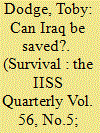

|
|
|
|
|
| Summary/Abstract |
Policymakers, journalists and pundits have struggled to understand the seizure of Mosul by the Islamic State of Iraq and al-Sham (ISIS) on 10 June 2014, the group’s drive south towards Baghdad and the collapse of the Iraqi army in the face of its advance. The way in which this fast-moving crisis is perceived will determine the response of leaders in Iraq, the wider Middle East and across the international system. It will not only shape the initial military response to ISIS but, much more importantly, the formulation of longer-term policies that aim to tackle the underlying causes of the group’s rise and its seizure of territory in both Iraq and Syria.
|
|
|
|
|
|
|
|
|
|
|
|
|
|
|
|
| 3 |
ID:
156019
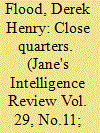

|
|
|
| 4 |
ID:
155482
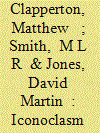

|
|
|
|
|
| Summary/Abstract |
This article analyses the way in which the group calling itself the Islamic State in Iraq and Syria (Islamic State) manages cultural heritage sites under its control. By drawing on three different cases—Palmyra; Sufi, Shi'a and Sunni heritage sites; and Mosul—it examines the way in which the logic of Islamic State's iconoclasm might also be considered a strategy. To be considered strategic the contention is that three factors need to prevail: the degradation and delegitimization of the existing societal fabric, the removal of all reference to the previous society, and an attempt to reconstruct society in keeping with a new ideological vision. When these three factors are present and interconnected then iconoclasm as a strategy can be said to be manifest. In the case of Islamic State, this article also seeks to illustrate that its actions may broadly be categorized as either pragmatic or dogmatic, thus creating an inconsistent dichotomy within Islamic State's rhetoric. The article frames such a dichotomy within the context of a strategic narrative both in order to be able to connect pragmatic Islamic State policy to action and to show that when rigid doctrine clashes with the exceptionality of war an irresolvable paradox is created.
|
|
|
|
|
|
|
|
|
|
|
|
|
|
|
|
| 5 |
ID:
162746
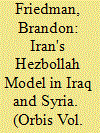

|
|
|
|
|
| Summary/Abstract |
This essay argues the wars in Iraq and Syria are not over. Iran has used the war against the Islamic State, and, more generally, the instability in Iraq and Syria, to successfully spread and legitimize its influence. If the U.S. intends to challenge Iran's influence in Syria and Iraq, it needs to demonstrate its long-term commitment to its local partners, and it needs to work with its partners to secure and stabilize eastern Syria and western Iraq. Countering Iran's influence in Iraq and Syria is a long-term project, and creating viable alternatives to Iranian influence in Damascus and Baghdad is the best way to prevent them from becoming long-term Iranian dependencies.
|
|
|
|
|
|
|
|
|
|
|
|
|
|
|
|
| 6 |
ID:
148669


|
|
|
|
|
| Summary/Abstract |
Following the uprisings in the Arab world, the region has lurched into a period of massive change and instability. An unfortunate consequence of this change has been the rise and proliferation of militant groups such as ISIS (Islamic State in Iraq and al-Sham) and Jubhat al-Nusra in Iraq and Syria. These militant groups successfully recruit members from the region and beyond, fueling conflict in countries that have witnessed unrest, such as Libya, Tunisia, Egypt, Yemen, Iraq, and Syria. Although Jordan has long been seen as a regional hub of stability and security, especially by its Western allies, it increasingly exhibits symptoms of the long-standing pressures exerted upon it by the surrounding conflicts, resulting refugee crises, and pre-existing domestic challenges. Jordan’s hypothetical fall into instability could have catastrophic consequences for the region, exacerbating the crises in Syria and Iraq, empowering ISIS and other militant groups, and threatening regional and global security. In response, this article offers a general framework for the expansion of the country’s nascent Counter Violent Extremism (CVE) program, including both preventative and remedial measures. Beginning with an overview of the processes of radicalization and de-radicalization, this article proceeds with a brief discussion of Jordan’s current situation before synthesizing scholarly articles and analyses of other CVE programs in order to establish a framework to guide Jordan’s developing CVE interventions.
|
|
|
|
|
|
|
|
|
|
|
|
|
|
|
|
| 7 |
ID:
151862
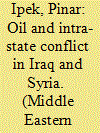

|
|
|
|
|
| Summary/Abstract |
The continuing dependency on fossil fuels of the Middle East not only in Turkey's energy mix but also in world energy demand requires further analysis of oil and conflict in the region since the fall of Mosul in Iraq to the Islamic State of Iraq and Syria in June 2014. This article addresses the relationship between oil and conflict. Then, it examines the case of Turkey's increasing energy relations with the Kurdistan Regional Government to elucidate the implications of inter-state and intra-state conflict on regional interdependence in the region. The argument asserts that risks of an abrupt regime change or revolutionary regime formation in the aftermath of civil war in Syria and ethnic or sectarian violence in Iraq, which are highly associated with intra-state conflicts, present challenges for Turkey's energy security and most importantly for human security in the region.
|
|
|
|
|
|
|
|
|
|
|
|
|
|
|
|
| 8 |
ID:
139034


|
|
|
|
|
| Summary/Abstract |
The protection of women, children and religious minorities was among the most prominent reasons US President Barack Obama offered for taking military action against the Islamic State of Iraq and al-Sham (ISIS): ‘They kill children. They enslave, rape and force women into marriage. They threatened a religious minority with genocide.’ Obama attributed singular malevolence to ISIS, claiming that ‘in a region that has known so much bloodshed, these terrorists are unique in their brutality’.
|
|
|
|
|
|
|
|
|
|
|
|
|
|
|
|
| 9 |
ID:
172552


|
|
|
|
|
| Summary/Abstract |
This article sets out to bring sound and music to the field of visual studies in International Relations. It argues that IR largely has approached the visual field as if it was without sound; neglecting how audial landscapes frame and direct our interpretation of moving imagery. Sound and music contribute to making imagery intelligible to us, we ‘hear the pictures’ often without noticing. The audial can for instance articulate a visual absence, or blast visual signs, bring out certain emotional stages or subjects’ inner life. Audial frames steer us in distinct directions, they can mute the cries of the wounded in war, or amplify the sounds of joy of soldiers shooting in the air. To bring the audial and the visual analytically and empirically together, the article therefore proposes four key analytical themes: 1) the audial–visual frame, 2) point of view/point of audition, 3) modes of audio-visual synchronization and 4) aesthetics moods. These are applied to a study of ‘war music videos’ in Iraq and Syria made and circulated by Shi'a militias currently fighting there. Such war music videos, it is suggested, are not just artefacts of popular culture, but have become integral parts of how warfare is practiced today, and one that is shared by soldiers in the US and Europe. War music videos are performing war, just as they shape how war is known by spectators and participants alike.
|
|
|
|
|
|
|
|
|
|
|
|
|
|
|
|
| 10 |
ID:
172054


|
|
|
|
|
| Summary/Abstract |
This study analyzes the demographics, criminality, and network relations of forty-one deceased Swedish foreign fighters. Our results show that most of the deceased Swedish foreign fighters were on average just under 26 years old when they died. Concerning network relations, nineteen out of the forty-one foreign fighters had at least one relationship (next-of-kin or friend) with another deceased foreign fighter. Two thirds were previously suspected of at least one crime. Based on our results, we argue that more attention needs to be given to tertiary and secondary prevention directed toward foreign fighter hubs.
|
|
|
|
|
|
|
|
|
|
|
|
|
|
|
|
|
|
|
|
|